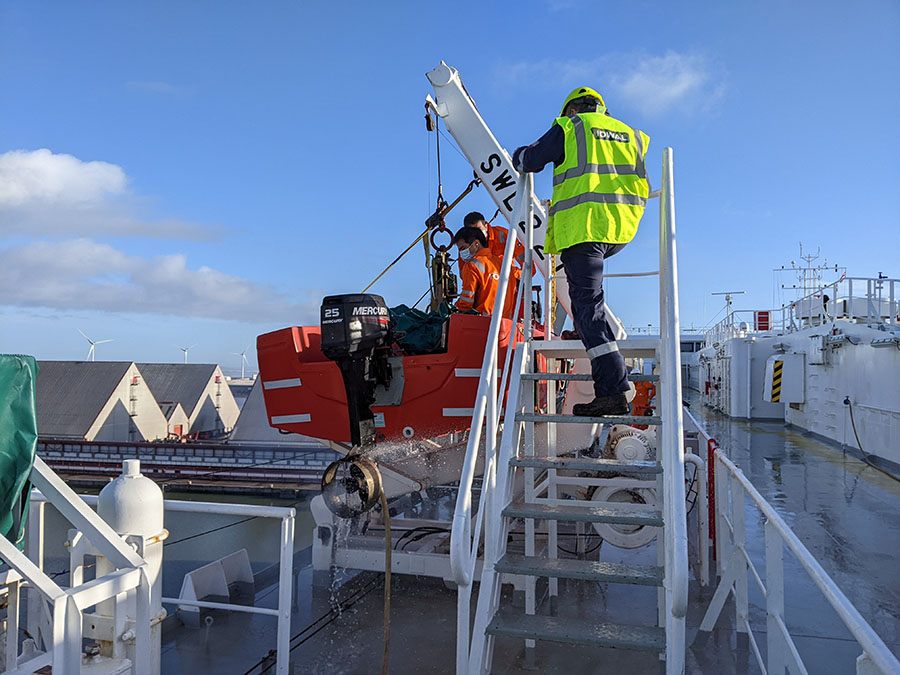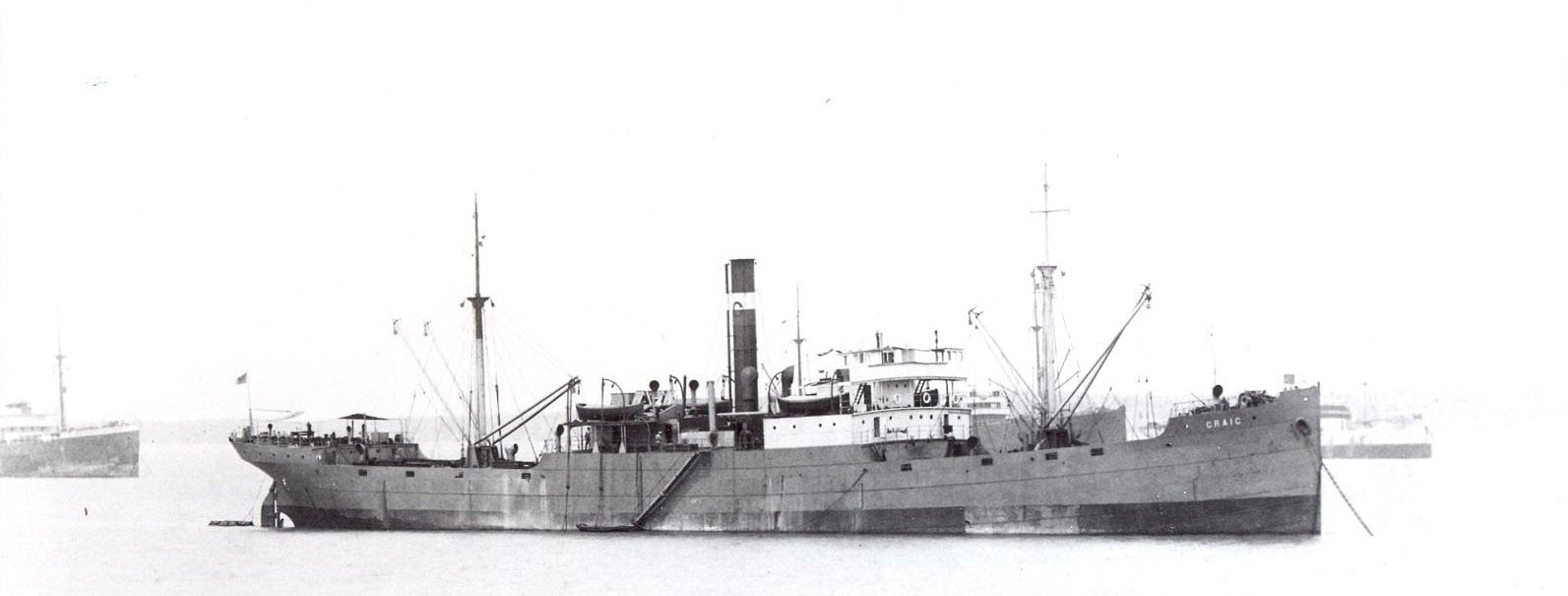
The following page contains excerpts from Graig's centenary book: One Hundred Years in Shipping. Request your book here.
Graig Shipping plc is a remarkable survivor. Whereas most family-owned British shipping companies have long since disappeared, Graig has succeeded in overcoming global conflict and periods of profound shipping depression to celebrate its centenary in 2019. What makes its survival even more remarkable is that it was born in an age of unprecedented commercial upheaval at Cardiff following the end of the First World War, when around 130 new shipping companies were promoted in the city in an eighteen-month boom that lasted from November 1918 to May 1920. Out of those 130 companies, Graig is the sole survivor of that incredible episode, when it was as if Cardiff’s shipowning community was gripped by a collective frenzy.
Graig begins with Idwal Williams
On the 15th July 1919, Idwal Williams founded Graig Shipping Co. Ltd. Incorporated in Cardiff at the heart of the city's commercial and shipping district, Graig acquired their first ship, the War Down, on 27th October 2019. Eventually renamed the Graig, she was placed under the day-to-day management of the new partnership of Idwal Williams and Company, comprising C.E.M. James Williams, George Williams and Idwal Williams.
The new venture was exceptionally fortunate that in Idwal Williams it had a seasoned ship manager who recognised that the post-war shipping boom, still climbing towards its heights in the autumn of 1919, was most unlikely to last that long. The crash in freight rates foreseen by Idwal and a few others, eventually hit in May 1920 and its effects soon reverberated to the east African coast with tonnage rates diving.
Idwal saw the slump in tonnage rates as an opportunity and in 1924 the steamship, Graig (2) was delivered with it's sister vessel, the Graigwen, being delivered the following year.
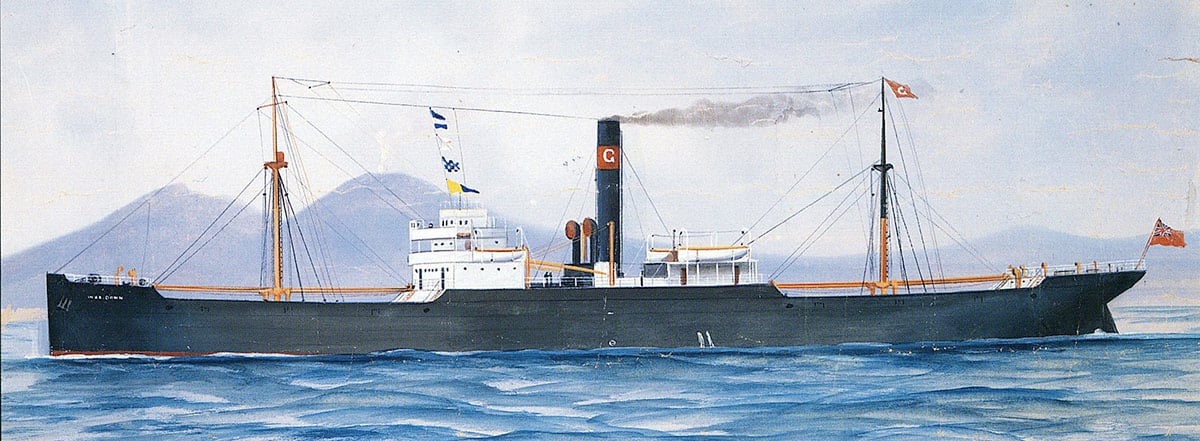
A pierhead painter’s portrait of the first Graig.
The Great Depression
In 1928, the Graig board consisted of George Williams as Chairman and Idwal Williams as Managing Director and Company Secretary. In 1929, disaster struck around the world with the Wall Street crash which led to a four year depression in the global shipping market. Idwal's response was to fit the Graigwen and the Graig (2) with a reheat system that allowed huge savings on coal whilst on voyage. Thanks to Idwal's stalwart reputation as a figurehead in shipping, Graig reached an agreement with North Eastern Marine Engineering Co Ltd to have both ships fitted with the new technology; this resulted in considerable cost savings in the running of both ships during those difficult years.
The voyage patterns of the Graig (2) and the Graigwen during the difficult 1920s and 1930s indicate that the outward coal trade to the River Plate, with return voyages of cereals (‘coal out, grain home’) remained important, but that Idwal Williams also used his skill and intimate knowledge of the tramp shipping trades to direct the two vessels elsewhere when opportunities arose.
Graig at War
On 1st September 1939, the Second World War broke out. All British ships were immediately brought under government control. Just under a year into the war, the Graiglas was delivered and unlike her sister the vessels, she would go on to survive the war.
The Graigwen was lost on 9 October 1940 when she was torpedoed by U103 around 250 miles west of the Hebrides, inward bound with a 6,160 ton cargo of maize from Montreal to Barry Roads for order. Despite having been badly damaged, the Graigwen stubbornly remained afloat, and it took a second torpedo the following day from U 123 to send her to the bottom.
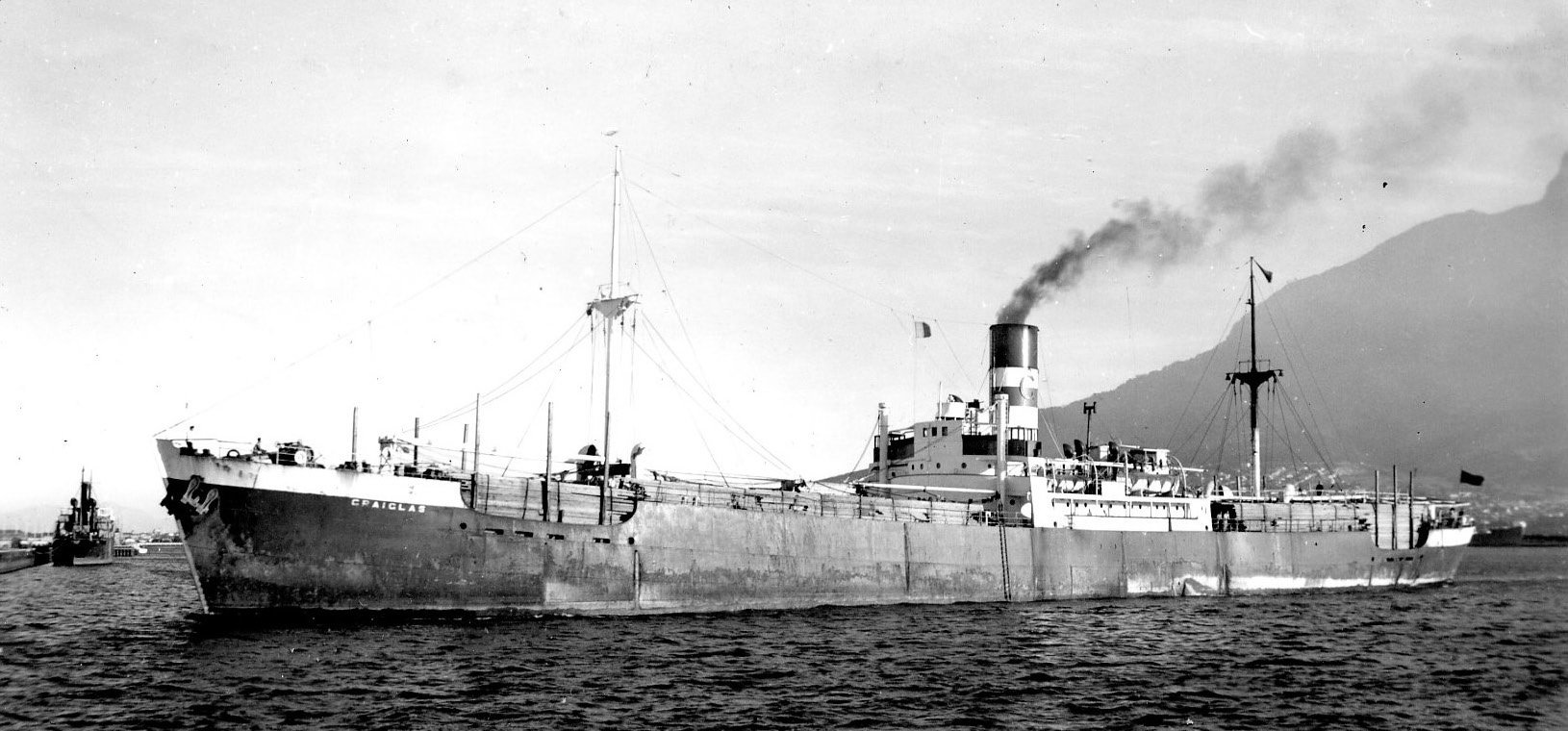
Graiglas of 1940 off the coast of Cape Town. Source: Ships in Focus.
Following the war, Graig Shipping re-established itself in its new offices, after a devastating fire in 1946 gutted the entirety of Graig's historical headquarters. John Frederick Williams, Dillwyn Spencer Williams and Desmond Idwal Williams were appointed directors of the management company.
Shipping was largely freed from government control by 1946 and there was a strictly controlled sale of standard merchant tonnage with Graig Shipping owning one ship, the Graiglas of 1940, whilst managing four others, the Ocean Vulcan, the Fort Chipewyan, the Empire Foam and the Empire Mariott.
Graig's First Motorship
Graig Shipping took a major step forward in 1952 with the purchase of the Basra Steam Shipping Co. Ltd adding the German-built oil tanker Repton and the recently completed Sherborne to Graig's fleet. A sister vessel to the Sherborne was also acquired in the deal; at the time she was still under construction at Lithgow’s Port Glasgow yard.
‘Stocky Mr. Idwal Williams, the 66-year old Cardiff shipowner, caught the 10am train to London yesterday to round off the City’s latest shipping deal, said to involve nearly £1,500,000. His Graig Shipping company has bought the Basra Steam Shipping business, which owns a 22-year old tanker, a new 9,000 ton tramp and another 9,000 tonner nearly finished building.’
In 1955 the company’s finance director and secretary, Daniel Richards, was appointed a director of Graig Shipping and his position as company secretary was taken by Keith Gowen, who had joined the firm in 1946. Shortly afterwards Desmond Williams returned from London to the Cardiff office and was appointed deputy chairman of both Idwal Williams and Co. Ltd and the Graig Shipping Co. Ltd. The fleet was further modernised in April 1957 with the purchase of the Swiss-owned General Guisan, renamed to the Graigfelen.
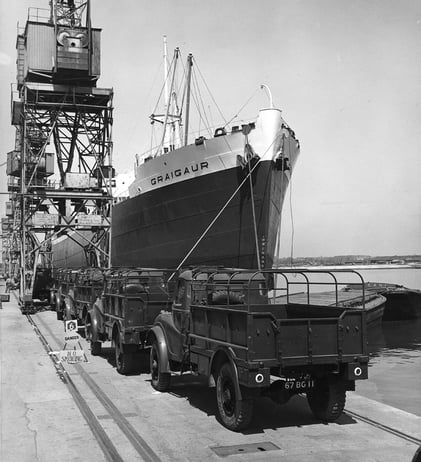
Graigaur loading military vehicles during the Suez crisis. Source: Fox Photos.
Through the seventies and into the eighties
Whilst shipping remained the company’s core business, from the early 1970s onwards it is clear that there was also a move within Graig Shipping towards treating ships, not primarily as assets whose trading brought the company its chief source of income, but also as commodities, whose sale and purchase, correctly-timed, could realise considerable profits over very short periods of time. This was first seen in the acquisition early in 1972 by the Garth Shipping Co. Ltd. of the 36,000dwt bulker Cluden, completed by Fairfield’s of Glasgow in 1965 for Matheson and Co. Ltd. of Hong Kong; she was renamed Garthnewydd. Just eight months later this vessel, which had cost £1.5m., was sold to Greek owners for over £2m.
Although freight rates remained depressed into the early 1980s, Graig bucked the trend somewhat with the sale of the Garthnewydd in 1981. Built in 1974 for $10.5m, she was sold that year to Portugese buyers for $18.5m! This left Graig with just one ship, the Graigwen, at a time when the freight market continued to be in dire straits, said by some to have been the worst slump in tramp shipping since the early 1930s. Nevertheless she proved to be a profitable and flexible vessel, with her ability to discharge her own cargoes quickly making her a sought-after vessel on the charter markets. Following the voyage to the Great Lakes referred to above, for instance, she was engaged upon a series of charters carrying cement clinker from Durban to Shuaiba in Kuwait, where she was able to discharge her entire cargo of some 28,000 tons in three days.
Hugh Williams Appointed as CEO
In 1993, Desmond Williams became the non-executive chairman of Graig Shipping, with Graig's current Chief Executive Officer, Hugh Williams, stepping in to lead the company. Following this, 1994 saw the creation of Graig Ship Management to offer a comprehensive ship management service to clients. Over the coming years Graig Ship Management would provide technical management for some forty vessels, chiefly multi-purpose cargo vessels, but also others as varied as specialist cement carriers and ro-ro car carriers.
 Hugh Williams, Chief Executive Officer of Graig Shipping PLC
Hugh Williams, Chief Executive Officer of Graig Shipping PLC
Eastern Promise
When Graig Shipping first announced its intention to build a series of vessels in a Chinese shipyards, there was some muted surprise expressed in shipping circles. The two established and reputable shipbuilding countries in the Far East were Japan and South Korea, whilst the output of Chinese shipyards was then thought to be technically inferior, not least in the standards of welding. However, the experience gained with the construction of the Confidence class vessels, and the technical improvements gained thereby, led to the realisation that Graig was in an ideal position to offer newbuilding supervision to shipowners wishing to place orders at Chinese yards. The business model established by Graig with the Confidence vessels soon saw the company acting in partnership with owners, designers and classification societies to produce ship designs which were then forwarded for contracting and series construction at a growing number of Chinese shipyards, as well as yards in Vietnam and India.
An interesting early project which proved Graig’s capabilities in this new business was the construction of a self-propelled jack-up vessel with accommodation, for the installation of wind turbines at off-shore locations for UK-based Mayflower Energy plc; the vessel was to be able to transport up to ten turbines and their component parts to locations at sea and was also equipped with a 500-tonne crane and a 300-tonne crane for subsequent at-site erection. The project entailed securing designers with experience in this field, the close co-operation of a classification society and a suitable shipyard capable of undertaking the construction of such a novel vessel. One particular requirement was that the vessel could jack itself up well above the waves, thus reducing exposure to bad weather and maximising the number of working days at sea. Eventually built at another Chinese yard at Shanhaiguan and completed in 2002, the $60m Mayflower Resolution project proved to be a highly successful co-operation between many different interests, and further consolidated Graig’s subsequent successful business model in the Far East.
 Graig/Idwal's Shanghai Office in 2020
Graig/Idwal's Shanghai Office in 2020
Today's Graig
A major change in the company’s operations came about in the summer of 2017 with the sale of Graig Ship Management to V. Ships, a global market leader ship management company registered in Monaco but with its operational headquarters in London, and some sixty offices world-wide. V. Ships had for some time been hoping to establish a more substantial presence in China and found the high reputation of the operation developed by Graig in the Far East, offering cost effective and high quality services in both shipbuilding and ship management to clients, very attractive. Following lengthy negotiations, the deal was concluded on 10 August 2017.
Despite this sale Graig Shipping remains innovative and committed to a future in shipping. The two bulk carriers continue in operation, whilst 2018 saw the launch of a new ship design, the geared 63,000dwt Diamond 2 bulk carrier whose specification reflects the move towards increasingly efficient and environmentally-conscious tonnage. These are concerns that can hardly have crossed the minds of Idwal Williams and his fellow directors a century ago as they acquired the first Graig, and they reflect how times have changed. The closure of Graig’s London office in the spring of 2018 is a recent reflection of the fact that there is no longer a need for a physical presence in the City’s shipping quarter in the way that there was in the early 1950s when it was opened.
In the modern shipping world, change is inevitable and it is by changing, and responding to change, that Graig has been a successful survivor. It adopted motor propulsion soon after the war and was the first Cardiff shipping company to acquire bulk carriers, thus enabling it to continue its participation in the world-wide tramping trades when other local companies were selling-up. The diversification of the 1970s and 1980s reflected the need to protect shareholders’ interests during volatile times for the company’s core shipping business, but the privatisation of the business in the 1990s has enabled the company to return to concentrate on that core business that it knows best. That Graig has changed and survived so effectively and successfully over the past one hundred years surely augurs well for the future.
Graig embarked upon a new shipping venture in 2010 with the creation of Idwal. The company’s principal activity is the provision of ship inspections for third parties, particularly focussed towards the international finance and sale and purchase sectors, covering pre-purchase inspections, general ship condition reports, pre-charter inspections and inspections for P & I (protection & indemnity) clubs, across vessels of all types. Idwal Marine has capitalised on the increasing move towards digitalisation within the maritime industry and in late 2016 launched an online platform to deliver its core inspection services, widely recognised as a pioneering initiative in the global inspection market. A dry-docking supervision service is also offered.
It is with a sense of enormous pride that we have celebrated Graig's centenary. We are proud of Graig's heritage, built on foundations of entrepreneurship, of strong ethics and of integrity - the ability to read cycles in the market, to spot opportunities, to innovate, to take calculated risks and to operate in the global way that we have. As times have changed, the Graig way has been to lead, not follow: with new solutions, new business models and new collaborations with major partners.
Here's to the next 100 years.
Hugh Williams, Graig Chief Executive Officer

Your partner for structuring shipping investments.
Graig Shipping PLC is registered in England and Wales No: 157048
5th Floor, 1 Capital Quarter, Tyndall Street, Cardiff, United Kingdom, CF10 4BZ
